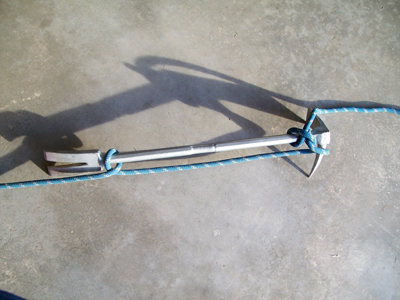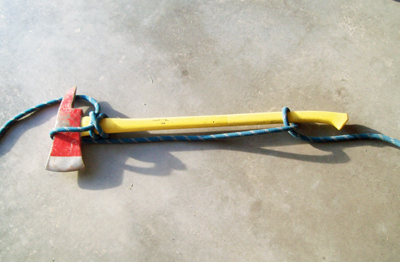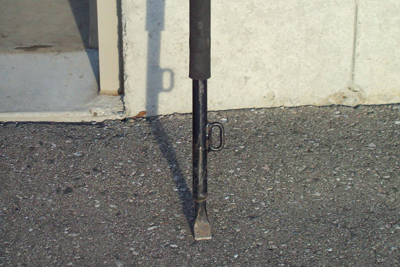
Features
Structural
Training
Back to Basics: March 2012
As discussed in previous columns, ventilation is an important task on the fire ground when trying to suppress fire.
March 19, 2012
By Mark van der Feyst
As discussed in previous columns, ventilation is an important task on the fire ground when trying to suppress fire. Ventilation helps to remove hot gases and smoke, reduces the chances of flashover, smoke explosions or backdraft, increases visibility in the structure and provides fresh air for victims inside. Every structure fire requires some form of ventilation; choosing the best method is sometimes the hard part.
 |
|
| Ventilating from above can be used in highrise buildings with flat roofs; firefighters can vent the window below from the floor above.
|
In a single-family residential structure, ventilation can be horizontal (with open windows and doors, using mechanical devices such as positive pressure fans or natural air currents), vertical (with a hole cut in the roof), or by hydraulic means. The bulk of your department’s structural fire calls is likely for residential buildings with peak roofs. But let’s turn our attention away from single-family residential structures and focus on commercial/industrial buildings, multiple-residential structures, highrises and low-rises. These types of buildings have at least two common features: height and flat roofs.
Buildings with these height variations present some obstacles to ventilating. The height may not allow for any ground-ladder access but may require aerial access, the roof type may be such that it cannot be cut easily, or perhaps the fire is between two floors in a multiple-storey building.
In these types of situations, one option is to ventilate the structure from above. If the building has windows close to the top of the roof or above where the fire is located, those windows are a great alternative. The rooftop will likely be accessed by ground ladder, by an aerial ladder, or by the building’s inside stairwell. If possible, establish a secondary means of escape before commencing any operation – just as we establish two ways off of a residential building.
It is vital to wear proper personal protective equipment when conducting this type of ventilation. You need to ensure that you are well protected with SCBA and structural firefighting gear given that you will be located above the fire and will be blasted with smoke and hot gases when the window is broken.
Ensure that the flat roof is safe. Sound the roof as you walk across it to check for structural integrity. If the roof feels soft or has too much bounce in it, it is probably not safe. You should also check visually for bubbling tar, which is never a good sign and needs to be avoided.
 |
|
| Photo 1: Secure the Halligan with a rope, using a clove hitch and a half hitch. |
It is important to bring a good set of tools with you whenever you conduct certain functions on the fire ground. For ventilation on a flat roof, you need:
- Roof hook or pike pole (preferably six feet long)
- Bag of utility rope
- Flat-head axe
- Halligan bar
- Rotary saw or chainsaw (preferably a rotary saw)
Bringing only an axe or pike pole limits your ability to complete the assigned task.
There are three ways to complete venting from above. The first method involves using a pike pole or a roof hook. The tools need to be long enough (minimum six feet, but the longer, the better) to allow you to reach over the edge of the building and break the glass out below. The firefighter who is breaking the glass will need to be secured by his partner so that he does not fall over the edge.
 |
|
| Photo 2: If there is no Halligan available, an axe will do the trick.
|
When breaking the glass, the firefighter needs to make sure that he does not lose the grip on the hand tool. Doing this requires a bit of upper-body strength. A striking action may be repeated a few times to ensure that the window is broken and cleared out enough to warrant effective ventilation. This process can cause fatigue if numerous windows need to be cleared.
The second method is to use a piece of rope and a hand tool, such as a Halligan. The idea here is to secure the hand tool with the rope and then toss it over the edge as a pendulum to break the window. First, secure the Halligan with the rope. Do this the same way you would prep the tool to hoist to the roof, as learned in Firefighter 1. As shown in photo 1, the Halligan is secured using a clove hitch and a half hitch. Do not use a rope larger than 12 millimetres (half an inch) in diameter – the smaller the diameter, the better. This allows you to ensure the hand tool is tightly secured and ready for deployment.
When the tool is secured, the firefighter will lower the tool over the edge to measure and mark where the window is. Once the hand tool is at the middle of the window, stop lowering it and use one of your hands to mark off the distance on the rope. The firefighter will position one hand (left or right) at the spot where the rope is supposed to pendulum in order to break the window. This hand will be the static, or anchor, hand, as it will not move when tossing the tool over the edge. Once the rope is marked, it can be retracted back up to the roof. When the firefighter is ready to toss the tool over, he will grab the hand tool and toss it over the edge, making sure the other hand (the static/anchor hand) does not move and is holding the rope at the proper mark. As the hand tool is being tossed out, it will swing like a pendulum and break the glass upon contact.
 |
|
| Photo 3: The six-foot roof hook has a link through which a carabineer can be hooked and attached to a rope to complete vertical ventilation. |
This action can be repeated several times to clear out as much glass as possible. A downside to this option is that the rope can be destroyed by glass pieces cutting it. This is why it is best to use utility (or other smaller diameter) rope over life-safety rope. A variation to this would be to use an axe as shown in photo 2.
The third method is to use a roof hook outfitted with a welded chain link at the bottom. As you can see in photo 3, the six-foot roof hook has a small link that allows you to hook in a small carabineer attached to a piece of rope or secure it with just rope and a figure-eight follow-through knot. The same operation can be conducted as described for the Halligan but with the roof hook. The disadvantage with the roof hook is that it is much lighter than the Halligan or the axe. The Halligan has more weight in the adze and spike end than the roof hook has in the hook end. The laws of physics and gravity mean that the Halligan is more effective. The Halligan can also be outfitted with a small link welded to it near the fork end, allowing it to be used in the same manner.
This technique of venting from above can be effective if conducted properly. It can be challenging to find a place in your community to practise this type of ventilation. Abandoned buildings that are slated for demolition are a great option. Getting permission will be the hard part.
Mark van der Feyst is a 13-year fire-service veteran who works with the City of Woodstock Fire Department in Ontario. He instructs in Canada, the United States and India. Contact him at Mark@FireStarTraining.com
Print this page